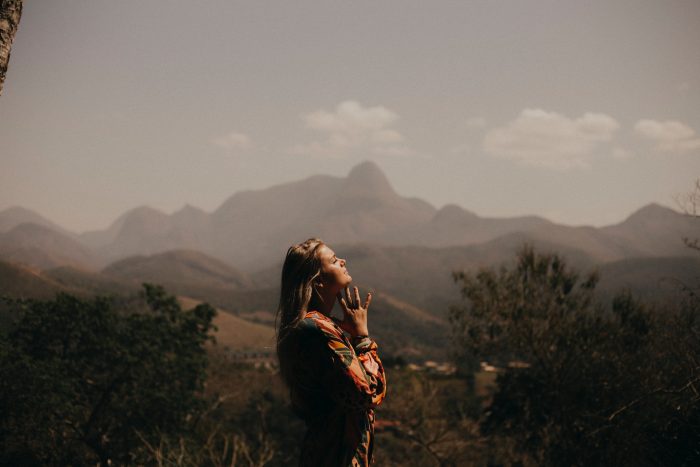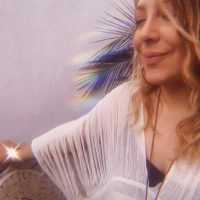If you experience anxiety, are anxiously attached, or perhaps find yourself wanting to avoid intimacy, you may have a mother wound that needs healing.
All relationships begin and end in separation, except for the relationship with our mothers, which biologically began in the most profound form of unity. We literally arrive on this earth automatically dependent on our mother, and therefore, it can be painful to experience criticism, rejection, avoidance, distance, or abuse from her.
No matter how available our mother is, there is a perceived deficit we experience in that primary relationship, which is internalized and influences our sense of safety and power. This void ends up being projected outward onto the people and circumstances of our life, particularly our intimate partner.
The imprint of attachment or abandonment in that primary dyad becomes the lens through which we interpret all other relationships and it heavily influences the way we relate to ourselves.
One of the primary tasks in the process of healing the mother wound is to identify our mother gap and consciously work to fill that gap by nurturing ourselves, rather than depending too much on others to fill it for us.
Healthy romantic partnerships can offer us the relational experience of nurturing, loving support, and connection we lacked, thereby supporting us to review the limiting narratives of our childhood—but they are not the complete answer to our healing.
Although our partners may be able to meet us with love, they will inevitably let us down too. Therefore, it is imperative that we cultivate a deep nurturing relationship within ourselves.
The honeymoon phase can often appeal to the deep need of our inner child to blend and belong, but in times of clashes and conflicts, it can cause our unresolved sadness, grief, and loss to be reactivated.
This activation of loss can trigger the experience of the black hole of the mother wound and often instigates the wounded inner child to take over the personality. This manifests as deep fear, hopelessness, powerlessness, unsafety, and loneliness.
As children, we did not have the resources to properly process the gap in nurturing and we develop coping mechanisms in the form of habits and compulsions to buffer ourselves from the pain. Some become insatiable in their thirst for external validation; others form additions.
What happened to us as children is not our fault, but as an adult, it is our responsibility to do the inner work in order to liberate ourselves from the grip of grief. We must stop distracting ourselves from the emotions and instead be willing to gently look deeply into these wounds and gently dissolve them.
The gap in connection to the mother evokes feelings of death because she is a primal source of life. This compels us to be radically present to the pain and not slip into compensating behaviors that further deplete our energy.
Our mother void can get triggered by negative or positive triggers. Any situations that remind us of the emotional pain experienced as a child is a negative trigger. Positive triggers, however, are activated when someone gives us the nurturing, love, and attention we’ve been yearning to experience. Either trigger can activate grief as it highlights the deficits in experiencing love and nurturing in the way we desired.
By activating conscious awareness of our inner child narratives and patterns, we can remain centered in our adult identity, consciously witnessing the gap without becoming overly identified with the old feelings.
By cultivating a trusting relationship with our inner child, we can begin to develop a loving voice inside our self that enables us to begin filling the void within.
An essential part of developing a loving relationship within is by redirecting behavioral patterns that keep us avoiding the void or filling it with the wrong things. This behavior mirrors the restlessness we may have felt as children when contact with mother was literally life or death.
The aim of the inner child work is to awaken our own inner mother and cultivate a strong connection with the archetypal Divine Mother.
By cultivating a connection with our own inner mother energy, we begin to reinstate safety and stability, compassion and calm. In this way, we integrate the abandoned parts of ourselves and transform deep levels of pain into conscious awareness, activating our full potential and spiritual gifts.
I guide my clients through a deeper dimension of this inner practice, inviting the Divine Feminine archetype to engage in the inner transmutation process. By developing a spiritual relationship with the Divine Feminine archetype, we invite in an even more potent level of unconditional support.
By sitting in the density of the Mother Wound, we can give birth to a new dimension of love within, one that will catapult us to rise to higher levels of being. By compassionately processing the original pain, we will develop a greater emotional capacity to hold space for ourselves and healthily navigate triggers.
The more our inner child trusts our inner mother—and the Divine Mother—the less time and effort it will require to process pain and transmute it. In time, our inner mother develops the capacity to meet our needs in a way they could never be met by our own mother, or anyone else for that matter.
The Divine Mother is an ever-present, all compassionate structure within us that can hold us safe no matter what is happening on the inside or outside. All things are permitted; everything is unconditionally understood and absolved through love.
The trinitarian structure of the inner child, inner mother, and divine parent archetype incrementally builds a strong foundation of safety within, which ultimately becomes the source of our inner liberation from the illusions cast by fear.
The Divine Mother reminds us we are atoms in the heart of the Holy. We are all intrinsically connected to one another despite our limited perceptions. In surrendering to the voice of love within, we give over our fear, and allow ourselves to be embraced by love—wholly and completely.
Once the inner mother is strong, then our animus or inner masculine emerges. As our capacity for inner nurturing improves, we give ourselves permission to be fiercely authentic. We feel safe and strong because we know now that we have an unconditionally safe inner space to retreat to when needed.
The inner masculine then has the ability to lean into vulnerability with ease and openness, permitting the pathway to deep intimacy with others. The masculine structure reinforces that it is safe to embrace the feminine creative intuitive flow and trust in oneself more unapologetically.
The integration of these two forces brings deep rest. There’s no longer impending doom or a sense of urgency and threat to our being. They mutually support each other to co-create an inner system of harmony and flexibility, resilience and rest. Over time, you become more courageous, sovereign, secure, and free.
This healing allows for deep spiritual union and intimacy with our partner within a relationship. Our connections are no longer based on attachment, codependency, and trauma bonding but rather are built in a foundation of awareness, vulnerability, agency, and real love.
Our partner’s flaws will no longer trigger insecurity or abandonment. We stop questioning our worth and value. We let go of what or who is no longer aligned sooner.
This inner work does not make us immune to triggers. How we respond and process them changes. An event may activate an old narrative, but we will have the ability to transform it much more effectively, remaining grounded in the core of our adult identity. And in so doing, we have a wider capacity to hold space for the tensions that arise in relationships so they can be healthily dealt with. What we offer the world (and our partners) from that place of inner intimacy is the greatest gift—it is true conscious love.
~
Please consider Boosting our authors’ articles in their first week to help them win Elephant’s Ecosystem so they can get paid and write more.
~













Read 1 comment and reply